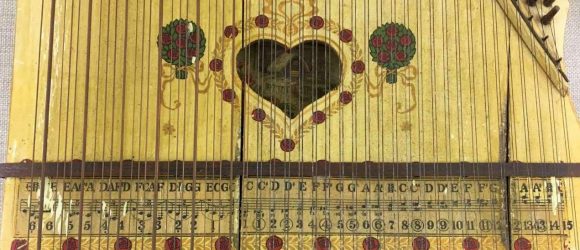Defense of the artistic research project “Changes in the Late 20th and Early 21st Century Concert Kanklės Repertoire and Contemporary Performance Trends”
- 2017-12-13
- | News

On December 14–15, 2017, the defense of Aistė Bružaitė’s artistic doctorate project “Changes in the Late 20th and Early 21st Century Concert Kanklės Repertoire and Contemporary Performance Trends” will take place at the Organum Concert Hall and the Lithuanian Academy of Music and Theatre. Artistic supervisor of the project – Prof. Lina Naikelienė, consultant – Prof. Rūta Rikterė, research supervisor – Prof. Habil. Dr. Daiva Vyčinienė, research consultant – Assoc. Prof. Dr. Laima Budzinauskienė. Copies of the research paper and its summary are available at the library of the Lithuanian Academy of Music and Theatre (Gedimino pr. 42).
Defense of the creative part of the artistic doctorate project
December 14, 2017, 6 p.m.
ORGANUM CONCERT HALL (J. Basanavičiaus str. 26, Vilnius)
CONCERT PROGRAM “THE CONCERT KANKLĖS. TODAY’S MUSIC”
Part 1
Vaida Striaupaitė-Beinarienė (1977) – Vandens atspindžiai (2017, piano/kanklės, transcription for amplified kanklės solo by Aistė Bružaitė, premiere)
Matti Kontio (1984) – Mitä soivat kirkonkellot? (2002, kantele, transcription for kanklės solo)
Valerij Kikta (1941) – “Умирающий Кентавр” из Диптиха по скульптурам Бурделя (1972, harp, transcription for kanklės solo);
“Призрачная колесница Кухулина“ из сюиты Из Оссиана (1968, harp, transcription for kanklės solo)
Kira Maidenberg (1985) – From Circe to Charybde / От Цирцеи к Харибде (2010, kanklės solo)
Kristine Ojala (1973) – 4 spēles (2000, kokles, transcription for kanklės solo)
Part 2
Lukrecija Petkutė (1988) – Religare (2010, violin, kanklės, basoon and double-bass, premiere)
Albertas Navickas (1986) – aš ilgai stovėsiu ant kranto, o tu vis plauksi upe (2010, violin, amplified kanklės, basoon and double-bass, premiere)
Alexander Ryndin (1962) – Magister verba (2017, violin, kanklės and cello, premiere)
Šarūnas Nakas (1962) – Affected Woman (2017, set of kanklės and wind instruments, premiere)
Performers: Aistė Bružaitė (kanklės, amplified kanklės, authentic kanklės), Ingrida Rupaitė-Petrikienė (violin), Tomas Ramančiūnas (cello), Donatas Bagurskas (double-bass), Darius Stoskeliūnas (basoon), Lithuanian Military Wind Orchestra (leader and conductor Egidijus Ališauskas)
Defense of the artistic research paper
December 15, 2017, 9.30 a.m.
LMTA JUOZAS KAROSAS HALL (Gedimino pr. 42, Vilnius)
CHAIR OF THE DEFENSE BOARD OF ARTISTIC RESEARCH PROJECT – Prof. Vytautas Tetenskas (Klaipėda University Academy of Arts, Music, Birbynė);
BOARD MEMBERS: Prof. Vaclovas Augustinas (Lithuanian Academy of Music and Theatre, Music, Composition), Prof. Wilfried Scharf (Anton Bruckner Private University for Music, Dance and Drama, Music, Zither), Prof. Dr. Rūta Stanevičiūtė-Kelmickienė (LMTA, Humanities, Art Research, Musicology), Prof. Dr. Audronė Žiūraitytė (LMTA, Humanities, Art Research, Musicology).
Abstract
In the late 20th century, the concert kanklės repertoire substantially changed. As the kanklės players’ school was getting more professional, increasingly more composers became interested in that Lithuanian instrument and expressed inovative ideas, unusual for the kanklės music performers and audiences, in their compositions. The present research paper chose to analyse the repertoire for the kanklės and chamber ensembles (which included the concert kanklės), its characteristics, and the changes in it in the period from the late 20th to early 21st century; it examined original compositions for the kanklės and conducted an in-depth study of the specificity of the instrument, technical possibilities of its performance, and the diversity of playing techniques. The most important and most striking solo compositions for the kanklės were identified, and their authors were introduced. The classical and contemporary kanklės repertoire, its changes, and the current composition trends were analysed separately. The paper presented a survey and its findings: during the survey, Lithuanian composers and musicologists were interviewed in order to identify their common insights into the concert kanklės opportunities and to evaluate its situation in the contemporary context of professional music. The concert kanklės playing techniques were comprehensively introduced and classified, and the traditional and nontraditional kanklės playing techniques were systematised in a table which also offered their examples and notation symbols. A separate overview of playing the new electric kanklės was included: the instrument has already attracted the attention of composers and got established in the context of contemporary professional music. The paper provided information about the instruments of foreign countries, related to the Lithuanian kanklės, and made attempts to establish certain links in the area of their performance. The latest trends in the compositions for concert kanklės were analysed and related to the implementation of their performance by identifying certain nuances and difficulties that performers tended to face. Four contemporary compositions from the concert kanklės repertoire were analysed (Piece G.r. by Egidija Medekšaitė, Snowing in Magnolia Blossoms by Vytautas Germanavičius, From Circe to Charybde by Kira Maidenberg, and Affected Woman by Šarūnas Nakas) that stood out due to innovative ideas and original playing techniques.

